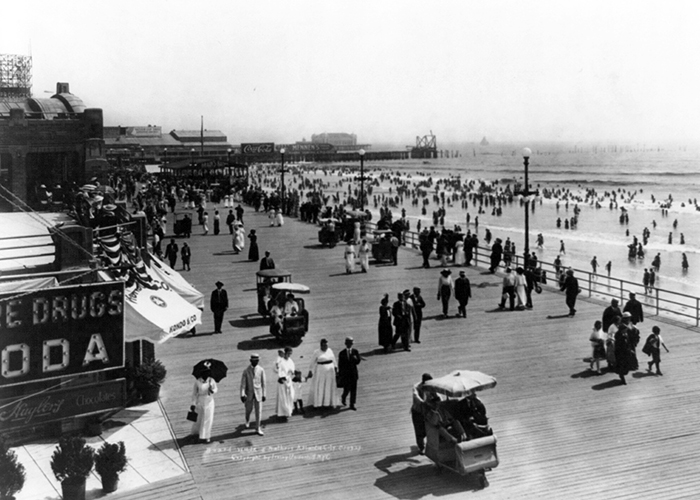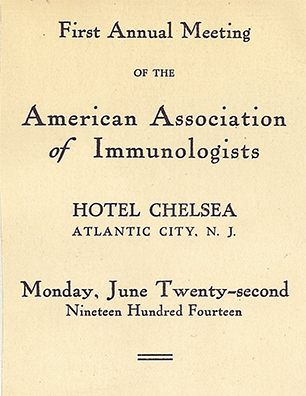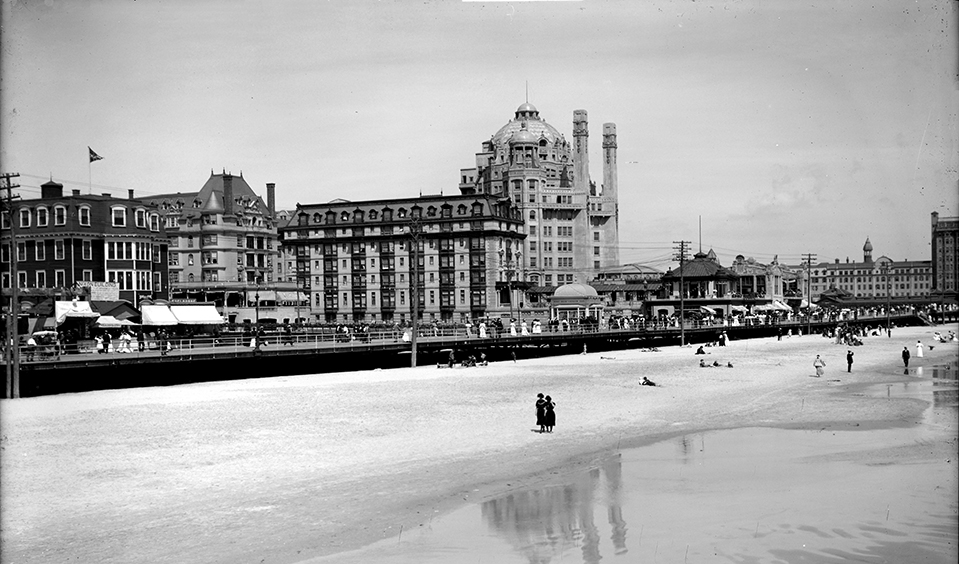Formative Years
Revisiting the First AAI Annual Meeting
by John S. Emrich
March/April 2016, pages 24–25
Having Marked Its 100th Anniversary in 2013, AAI Celebrates the Centennials of Its Annual Meeting and The JI in 2016
 Boardwalk and bathers, Atlantic City, 1915
Boardwalk and bathers, Atlantic City, 1915
Library of CongressOn a pleasantly warm Monday, June 22, 1914, 40 attendees arrived at the Hotel Chelsea in Atlantic City, New Jersey, for the first annual meeting of The American Association of Immunologists (AAI). This May, 102 years later, the association will hold its 100th annual meeting in Seattle, Washington, with attendance expected to exceed 3,000.
The scientific program for the 100th AAI annual meeting, IMMUNOLOGY 2016™, is to span four full days, with presentations by nearly 100 plenary session lecturers and panelists in major symposia, plus the panelists in 16 guest society symposia, NIH symposia, and career development sessions. Approximately 2,000 scientists at every career stage will present their work in 82 block symposia and poster presentations on 22 abstract topics. In addition to sessions on leading-edge research in established fields, the meeting will feature sessions on emerging fields of immunology and technology. Almost 150 exhibitors will be present to showcase the newest tools and resources available to researchers in the field. AAI Annual Meeting program, 1914
AAI Annual Meeting program, 1914
AAI Archive
At IMMUNOLOGY 2016™, The Journal of Immunology (The JI) will celebrate its own centennial with special exhibits and events and will host its own booth in the Skybridge portion of the AAI Exhibit Hall.
Why is the 2016 meeting in Seattle the 100th annual meeting if the first was in 1914? A historical hiccup caused by the Second World War is the reason that the AAI annual meeting is currently in sync with the age of The JI and not AAI itself. In 1943, 1944, and 1945, wartime travel restrictions in the United States forced the cancelation of national annual meetings for scientific societies large and small, including AAI and all members of the Federation of American Societies for Experimental Biology (FASEB). The AAI meeting in 1943, scheduled to be held in Cleveland, was to be the first annual meeting of AAI as a member society of FASEB, but the meeting was canceled less than one month out. The 1944 and 1945 meetings were also scheduled for Cleveland, but each had to be canceled as well. Since the end of the war, however, all scheduled AAI annual meetings have occurred as planned.
The location of the first annual meeting was determined by the location of the American Medical Association (AMA) meeting, as was the case for the AAI founders’ meeting in Minneapolis the previous year. In that most AAI members were physicians and also members of the AMA, the first AAI Council resolved to hold the smaller AAI meeting one day before the AMA meeting began with its anticipated 4,000 attendees. Among the 40 AAI attendees was a particularly engaged Victor C. Vaughan (AAI ’15), then the current AMA president. Others in attendance included future AAI Presidents William H. Park (AAI 1916, president 1918–19) and Jacque J. Bronfenbrenner (AAI 1920, president 1942–46).
 Beach and boardwalk, Atlantic City, 1915
Beach and boardwalk, Atlantic City, 1915
Library of CongressA one-hour-long AAI Council meeting preceded the 10:00 AM formal opening of the inaugural annual meeting. The “Address of Welcome” by AAI President Gerald B. Webb (AAI 1913, president 1913–15) was followed by a roll call, an election of officers and members, and the adoption of a constitution and bylaws. Martin J. Synnott (AAI 1913), AAI secretary, reported on how the association had been founded and presciently predicted that the AAI would soon be “one of the most important medical organizations on this continent.”
The first scientific session began with George H. Smith of H. K. Mulford Company, Glenolden, Pennsylvania, delivering his paper, “The Production, through Immunization, of Specific Ferments against Bacteria: as Detected by the Abderhalden Test.” The meeting lasted one full day, consisting of three sessions and a total of 19 basic and clinical research talks, including the president’s address. Each presentation was followed by an open discussion led by an invited scientist. (To learn more about the science at the meeting, see Litzinger, “Science at the First AAI Meeting.”) At the meeting, the editor of the Journal of the American Medical Association requested a report of the proceedings for publication in the journal.
During the next four decades the AAI meeting was held as a stand-alone meeting or concurrently with other societies, including multiple times with the American Association of Pathologists and Bacteriologists (now American Society for Investigative Pathology). Following the acceptance of membership in FASEB and the resumption of meetings after the Second World War, the AAI annual meeting took place as part of the FASEB annual meeting (now Experimental Biology) from 1946 through 2005 with the exception of eight meetings that were joint meetings with other societies or stand-alone meetings. Since 2005, AAI has held stand-alone meetings, with the exception of its co-location with Experimental Biology in 2008.
Geographically, the AAI annual meetings remained exclusively in the East and Midwest for four decades, with Atlantic City; Philadelphia; New York City; Chicago; Washington, DC; and Toronto each hosting multiple times. In 1955 the first meeting west of the Mississippi River took place in San Francisco. The first meeting in the Pacific Northwest did not occur until IMMUNOLOGY 2000™ in Seattle, but with IMMUNOLOGY 2016™, AAI will have met a third time in Seattle since 2000. The 100 annual meetings have included stops in 27 different cities in 18 states; the District of Columbia; and Ontario, Canada.
More information on the early years of AAI will be featured in the updated AAI Centennial Timeline to be displayed in the Skybridge portion of the Exhibit Hall at the 2016 AAI annual meeting. Attendees will also be able to view a special exhibit on the first AAI annual meeting as well as the leading immunology scientists and institutions in Seattle. The History Exhibit will be located on the 6th floor of the Washington State Convention Center.
References
- Emrich, John S., “The Founding of AAI.” AAI Newsletter. May/June 2012.
- Litzinger, Mary. “Science at the First AAI Annual Meeting.” AAI Newsletter. May/June 2012.
- “M.D.’s at Atlantic City.” New York Times. June 22, 1914.
- Program of the First Annual Meeting of the American Association of Immunologists. June 21, 1914. AAI Archive, Rockville, MD.“Society Reports: American Association of Immunologists,” Medical Record 86, no. 22 (1914): 942–946.
- “Today’s Sun and Tide Table.” New York Times. June 23, 1914.